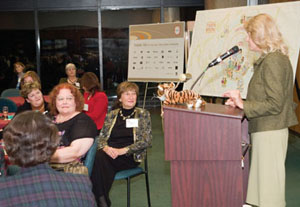By Kelly Brooks-Staub

“We must use science to put power into the hands of the caregiver and extend our abilities to give better care,” urged professor Marion Ball, EdD. “We need to put the latest tools into the hands of those who take care of patients around the world.”
Ball’s welcoming remarks set the tone last October for the 2006 Summit of the Technology Informatics Guiding Educational Reform (TIGER) initiative, held at the Armed Services University.
As co-chair of the TIGER executive committee, Ball spent more than two years preparing for the summit, along with the other representatives from academia, government, and industry who comprise the TIGER team. The group of volunteers was launched into action after a meeting at the Johns Hopkins University School of Nursing in January 2005, with the visionary support of Dean Martha N. Hill, PhD, RN, FAAN. The mission: To enable practicing nurses and nursing students to fully engage in health care’s unfolding digital electronic era.
“We need to change the ‘thought flow’ of every nurse and nursing student,” says Ball. “Nurses of the future won’t be going through the linear process of patient assessment and writing out care plans. They’ll need to make decisions guided by evidence-based practice. So we are teaching nurses how to use technology to find and record the information they need and use critical thinking skills—rather than memorization—to determine the best course of action for a patient.”
To address this inevitable technological transformation, 120 leaders from over 40 nursing practice organizations, educational institutions, informatics and technology businesses, and government agencies gathered at the summit—using a consensus process—to create a three-year plan of action. “This was one of the most collaborative experiences of my lifetime,” says TIGER program committee chair Michelle Troseth, RN, MSN, vice-president and chief professional practice officer of the Clinical Practice Model Resource Center and Eclipsys Corporation. “Everyone in the room—all volunteers—set aside their individual status and affiliations to work together for the sake of the nursing profession. They were there to create a better world for every nurse at the bedside.”
Troseth has demonstrated innovative technology across the nation, including in the Hopkins/Eclipsys Healthcare Information Technology lab at the School of Nursing, which is a national model for bridging nursing education and nursing practice. In simulated health care situations, students are able to learn assessment skills, develop an individualized plan of care, determine a course of action, and evaluate progress of care provided—using evidence-based clinical con-tent and knowledge-based tools.
“These kinds of tools help students organize the way that they care for patients and critically think,” explains Ball. “Even if they don’t have access to these tools when they leave school, the thought flow and critical thinking will stick with them. Many students become advocates for these technologies in their places of work.”
“The TIGER Initiative will change the entire future of nursing. We are in a position to make a major difference in the field of nursing,” says Ball. “Information technology is going to become the stethoscope for the 21st century.”